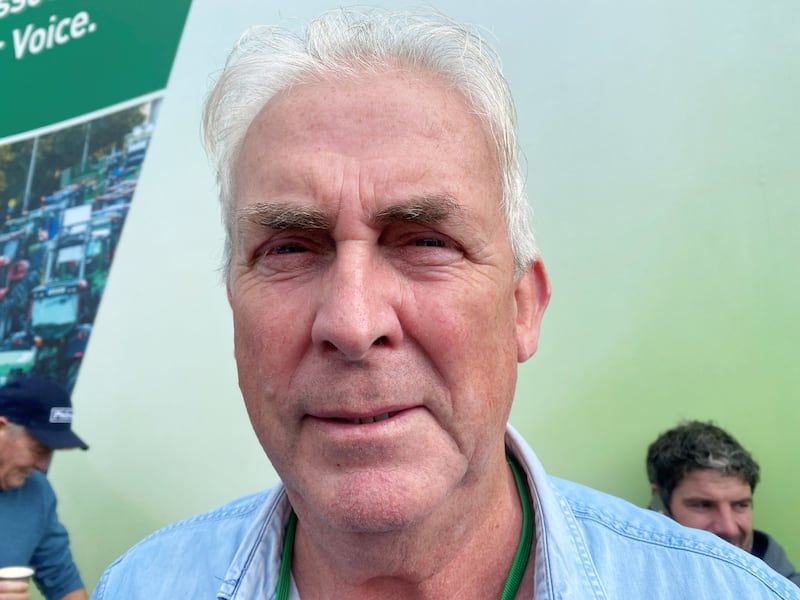Dairy farmer: Con O’Leary milks 130 cows on his farm in Donaghamore in Co Cork: “The milk price got really good. We couldn’t imagine how good it would get. This time last year milk was 37 cents per litre. We are on 65c at the moment. That’s a huge increase, but fertiliser has trebled in price from €280 to €900 a ton and meal has doubled. We have a raft of ongoing concerns over regulation and where that may go. You have the CAP, you have nitrates, you have the climate action bill. All of that is one side of concern about where our industry is going.
“Previously you would be buying fertiliser forward for next year, but we really don’t know where things are going. Through the calving period, I found very good forward, progressive farmers and their head space is in a place of concern, but I would say that dairy farmers’ bank accounts should be in a better place.
“But it has worked through that the milk price has increased since last spring and that has offset the costs. We are making money despite the costs. The concern is where we are going. We are buying forward at full cost now for next year. When it (milk price) starts to go on the downturn, how much do we need to bank now? People are going to have to look forward. Will regulation force a change on our business? Do we have to increase our output? Are we going to have to decrease our stock? How is that going to impact cashflow budgets? Will the milk price hold strong enough next year? We think it will.”

Tillage farmer: Max Potterton has 600 acres of tillage in Co Meath, where he grows wheat, barley, oil seed rape and oats. “We are coming out of very high prices because global grain prices are very high as a result of the war in Ukraine. The war is driving grain prices to historic levels. This year has been very, very good. Last year we were getting €180 to €190 a ton for grain. This year it will be in the region of €300 a ton. Generally speaking cereal prices all track one other. Barley is our main one this year and was €200 a ton off the combine harvester last year. This year it is €290 to €300 a ton.
“That said, nitrogen fertiliser is €800 to €900 a ton due to the gas crisis in Europe. 2022 is definitely better than 2021, but there is major uncertainty going into 2023 with the input level. 2022 is a positive year for the sector no doubt, but we don’t know what we are going to get in 2023. We expect grain prices to be slightly lower. The weather has been good. August typically in the east of the country can be the wettest month of the year. This year it is the total opposite. The weather was a real pleasure for us this year. Yields are generally good. Spring barley and winter wheat were above average.”

Beef farms: Michael Biggins from Glencorrib, Co Mayo. He keeps 70 suckler cows. “Beef prices are stable and they would be adequate if we were talking this time last year. Beef prices have gone from €4 a kilo to almost €5. Yet when you go into a supermarket, there is a massive increase in the price of steak. You’d imagine we were getting €10 a kilo at the farm gate which we are certainly not getting. There is a lot of gouging going on. We are at the complete mercy of the supermarkets.
“At long last we would be getting a return on our product, but, when you factor in the inflationary costs, bearing in mind that farm families have the same inflationary costs as other families, it is a serious thing for us. What is the impact that inflation is going to have on food? People will go for the cheaper options. Weaning sales (calves coming off the cows) have only started now and they have started positively. They need to be positive because of the astronomical costs. You can see the exit from our sector right around the country. It is a low income sector.
“The trouble is that a lot of the land in Ireland is only suited for suckler cows. You can’t have dairy cows when you have fragmented land. Sucklers are vital in a huge amount of areas. A lot of people would be feeding off the suckler industry. It is challenging because of the costs involved. What a lot of farmers have done is cut back substantially on fertiliser. You can see driving around the country what was a green place is not now because of the lack of fertiliser. On a rolling basis it is going to serious affect the productivity of that land.”

Roy Gallie from Broadford, Co Kildare: He has 4,000 pigs: “This year has been the worst period that any members of the pig farming community can ever remember. Our pandemic started before the Covid-19 pandemic. There was an African swine fever outbreak in China which went through the pig population. China is the biggest consumer and producer of pig meat in the world. It led to a spike in prices because we were heading for a global shortage of pig meat. We in Europe started to ramp up our production levels and the minute we did, Covid-19 started. We couldn’t get the pig meat to China. That left a lot of pigs on the European market and an oversupply. The Chinese started to build nine- or 10-storey piggeries in biosecure units.
“Ireland also has a huge surplus of pigs because of Brexit. The factories couldn’t get the workers to kill pigs in the North so they sent them down to the South. Pigs on farms got heavier. Eventually we managed to get things under control and then the war in Ukraine happened. Feed and fertiliser has doubled in cost. All of this together has led to the pig price going up as well, but it has not kept up with costs. We are now still in a loss-making situation on pig farms. We are getting €2.10 per kilo and we need €2.30 per kilo just to break even. We got a bit of a subsidy from Government and an emergency payment of up to €100,000. I got €60,000 and it makes a difference to a farm of my size, but for the bigger guys that €100,000 is of little significance in producing a pig.”


